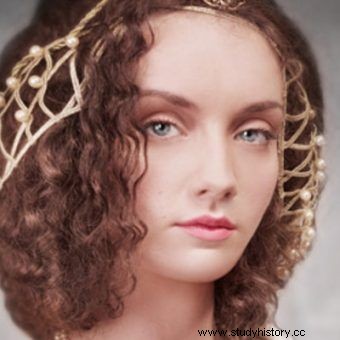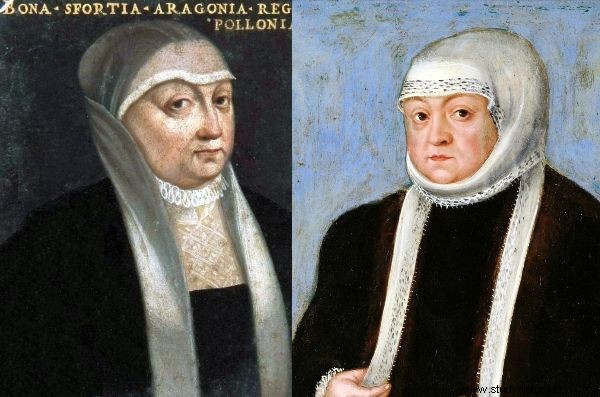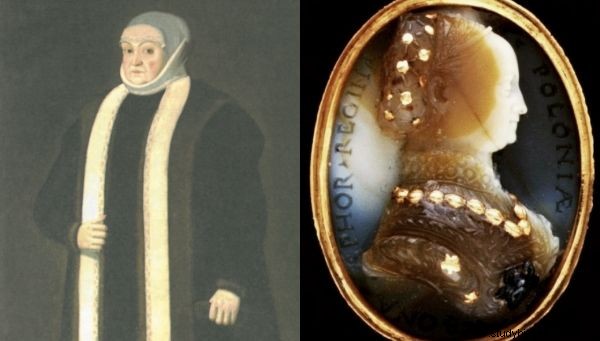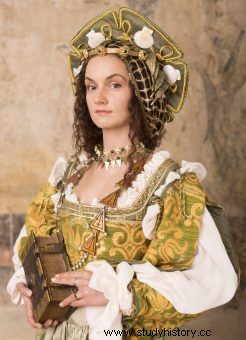She was not a ruthless poisoner. She did not plunder the Polish state and did not take other people's treasures to Italy. And most of all - she was not a fat, hideous bastard at all. Contrary to what almost every portrait of her would suggest.
There is no escape from the stereotypical image of Bona Sforza. Her face is haunted by the pages of every school textbook. The Queen comes in several different versions. However, it is always an elderly lady with extremely unattractive facial features and morbid overweight. The gloomy impression is enhanced by the monarch's outfit.

Anna Knybel as Bona Sforza on the cover of "Ladies of the Golden Age".
A mourning veil and a simple widow's gown, reminiscent of sackcloth. Added to this is the perpetually sullen, gloomy face, sunken, teary eyes and a vulgar protruding chin. In a word:the view is not amazing.

Bona does not impress with her appearance in any of the painterly portraits ...
All these portraits were created after 1548 - that is, after the death of Bona's husband and the Polish king, Zygmunt Stary. The ruler, who was well over 50 at the time, could be forgiven for not having the first freshness of beauty. The problem, however, is that the images just lie. Bona did not look like this, even in the last years of her life.
Lost Portraits
Several images have been preserved that reflect the true beauty of the queen who was advanced in her years. These are medals with her likeness, and above all, a wonderful cameo that Bona gave as a gift to the German emperor.

On some it looks downright disgusting. For comparison:a cameo currently in the collection of the Metropolitan Museum of Art in New York.
In this portrait, Bona is about fifty years old. She is not a model, but she is also nothing like the depressed widow in the paintings. She is proud and majestic, like the successor of the ancient goddesses of war and wisdom.
The cameo, as a small piece of jewelry, does not reflect the details of the ruler's appearance. These, however, can be found in a different image of her - not only the last one, but also strikingly realistic. Made in three dimensions and taking into account all details.
Beauty that does not go away with age
We are talking about a sculpture depicting the queen, placed above her grave in Bari, Italy. This endearing work of art was commissioned by Bona's daughter, Anna Jagiellonka, based on an unknown portrait of the queen.

The Mausoleum of Bona Sforza in Bari (photo:Kamil Janicki).
In the main nave of the Basilica of Saint Nicholas, you can admire the tasteful, aristocratic beauty of the Polish ruler, visible even at the end of her life. The Queen, with her hands folded in prayer, is kneeling on a pillow, wearing a simple but elegant gown and a long coat. Her face is proud, pretty and calm. She looks like a majestic matron, not a tired widow.
Fashion and chauvinism
Why does it look completely different in the portraits known from textbooks? And why did she allow her to appear in such an eminently unfavorable way, if a whole series of works of art deny that she was a hideous witch? Fashion owed everything. Of course - created by men.
In the 16th century it was common to portray widows in an almost caricature way. It was about showing the deep suffering and confusion of a woman who was deprived of her only support in life. And even more. In keeping with the epoch's imagination, viewers were instilled in the belief that an aristocrat, losing her husband, loses everything overnight. The meaning of existence, all physical qualities and every last trace of youthful beauty.
The widow portraits of Bona show not so much the real queen as the chauvinism of the era. Because, of course, no one has disfigured widowed men.
Mouth reddish coral
Ironically, not only was Bona not hideous, but her stunning beauty was widely praised in her youth. As a 24-year-old she was described as follows:
The hair has a lovely pale tan, while (oddly enough) the eyelashes and eyebrows are completely black. Eyes angelic rather than human, forehead radiant and cheerful. Straight nose, no hump or curve.
The faces are browned with an innate modesty. The mouth is the reddest coral, the teeth are even and extraordinarily white, the neck is straight and round. The chest of snow white, the arms the most effective, the more beautiful hand cannot be seen.
Everything taken together, whether the whole figure or each member separately, make up the loveliest and most charming whole.

Bona Sforza on a woodcut from 1521.
Unfortunately, only one portrait of young Bona has survived to this day - quite a schematic woodcut illustrating the work On the Antiquities of Poles, published in 1521.
The sleeve is sliding off nonchalantly
The queen depicted in it is not yet thirty years old. She is a delicately beautiful lady, but certainly not a flapper. She looks ahead proudly, only a faint smile on her face.

Anna Knybel as Bona Sforza. In fact, this is what the greatest Polish queen looked like.
She wears an outfit that in Poland had to shock as many people as it was delighting - an Italian dress with a deep square neckline . There is also a scrap of a thin shirt underneath it that opens between her breasts. The creation is full of details, and the whole is completed by two rows of jewels hung around the neck. "The left sleeve slips nonchalantly from the shoulder, as can be seen in other portraits of Italian women from this period," adds Renaissance fashion expert Maria Molenda. The most peculiar, however, is the queen's headdress. Her hair is covered with a delicate net, on which the ruler has put a headband with flowers and an elaborate beret. Its large brim may be decorated with golden seashells.
What was Bona really like?
As a black and white drawing, this portrait went almost unnoticed. It is difficult to use it as an attractive illustration, so it is no wonder that the image of the ugly Bona lingers in the common imagination. While working on his new book, Ladies of the Golden Age , I couldn't miss an opportunity to do something about this damaging stereotype.
Together with the Nomina Rosae foundation from Nowy Sącz, the best specialists in the reconstruction of historical costumes in the country, we decided to bring Bona back to life after 500 years. We found a model with the features of the appearance that fully reflect the beauty of young Bona. Although she is Polish, Anna Knybel, she cannot be denied Italian, perfectly royal beauty.
Almost everything is correct - facial features, skin color, even the shape of the nose and the line of the lips. Having the new Bona, the foundation prepared an outfit that reflects every detail a dress visible on a woodcut from 1521. This is what Bona Sforza really looked like - one of the most beautiful women of her time.
Source:
You can learn more about the confusing history of the Jagiellonian family in Kamil Janicki's book Ladies of the golden age (Horizon 2014 sign.
